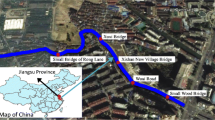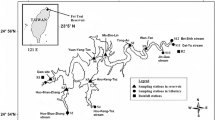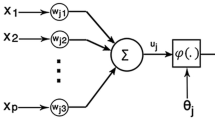Abstract
Identification and quantification of dissolved oxygen (DO) profiles of river is one of the primary concerns for water resources managers. In this research, an artificial neural network (ANN) was developed to simulate the DO concentrations in the Heihe River, Northwestern China. A three-layer back-propagation ANN was used with the Bayesian regularization training algorithm. The input variables of the neural network were pH, electrical conductivity, chloride (Cl−), calcium (Ca2+), total alkalinity, total hardness, nitrate nitrogen (NO3-N), and ammonical nitrogen (NH4-N). The ANN structure with 14 hidden neurons obtained the best selection. By making comparison between the results of the ANN model and the measured data on the basis of correlation coefficient (r) and root mean square error (RMSE), a good model-fitting DO values indicated the effectiveness of neural network model. It is found that the coefficient of correlation (r) values for the training, validation, and test sets were 0.9654, 0.9841, and 0.9680, respectively, and the respective values of RMSE for the training, validation, and test sets were 0.4272, 0.3667, and 0.4570, respectively. Sensitivity analysis was used to determine the influence of input variables on the dependent variable. The most effective inputs were determined as pH, NO3-N, NH4-N, and Ca2+. Cl− was found to be least effective variables on the proposed model. The identified ANN model can be used to simulate the water quality parameters.




Similar content being viewed by others
References
Anctil, F., Perrin, C., & Andreassian, V. (2004). Impact of the length of observed records on the performance of ANN and of conceptual parsimonious rainfall-runoff forecasting models. Environmental Modelling and Software, 19, 357–368.
Anctil, F., Filion, M., & Tournebize, J. (2009). A neural network experiment on the simulation of daily nitrate-nitrogen and suspended sediment fluxes from a small agricultural catchment. Ecological Modelling, 220, 879–887.
Ansa-Ansare, O. D., Marr, I. L., & Cresser, M. S. (2000). Evaluation of modelled and measured patterns of dissolved oxygen in a freshwater lake as an indicator of the presence of biodegradable organic pollution. Water Research, 34, 1079–1088.
APHA. (1995). Standard methods for the examination of water and wastewater (19th ed.). Washington: American Public Health Association.
Banerjee, P., Singh, V. S., Chatttopadhyay, K., Chandra, P. C., & Singh, B. (2011). Artificial neural network model as a potential alternative for groundwater salinity forecasting. Journal of Hydrology, 398, 212–220.
Chang, F. J., Kao, L. S., Kuo, Y. M., & Liu, C. W. (2010). Artificial neural networks for estimating regional arsenic concentrations in a blackfoot disease area in Taiwan. Journal of Hydrology, 388, 65–76.
Cherkassky, V., & Mulier, F. (1998). Learning from data: Concepts, theory, and methods. U.S.A.: Wiley.
Coulibaly, P., Anctil, F., Aravena, R., & Bobée, B. (2001). Artificial neural network modeling of water table depth fluctuations. Water Resources Research, 37, 885–896.
Coulibaly, P., Bobee, B., & Anctil, F. (2001). Improving extreme hydrologic events forecasting using a new criterion for artificial neural network selection. Hydrological Processes, 15, 1533–1536.
da Costa, A. O., Silva, P. F., Sabara, M. G., & Da Costa, E. F., Jr. (2009). Use of neural networks for monitoring surface water quality changes in a neotropical urban stream. Environmental Monitoring and Assessment, 155, 527–538.
Daliakopoulos, I. N., Coulibaly, P., & Tsanis, I. K. (2005). Groundwater level forecasting using artificial neural networks. Journal of Hydrology, 309, 229–240.
Dastorani, M. T., Moghadamnia, A., Piri, J., & Rico-Ramirez, M. (2010). Application of ANN and ANFIS models for reconstructing missing flow data. Environmental Monitoring and Assessment, 166, 421–434.
Dixon, B. (2005). Applicability of neuro-fuzzy techniques in predicting ground-water vulnerability: a GIS-based sensitivity analysis. Journal of Hydrology, 309, 17–38.
Dogan, E., Sengorur, B., & Koklu, R. (2009). Modeling biological oxygen demand of the Melen River in Turkey using an artificial neural network technique. Journal of Environmental Management, 90, 1229–1235.
Elmolla, E. S., Chaudhuri, M., & Eltoukhy, M. M. (2010). The use of artificial neural network (ANN) for modeling of COD removal from antibiotic aqueous solution by the Fenton process. Journal of hazardous materials, 179, 127–34.
Fletcher, D., & Goss, E. (1993). Forecasting with neural networks: an application using bankruptcy data. Information Management, 24, 159–167.
Freeman, J. A., & Skapura, D. M. (1991). Neural networks: algorithms, applications, and programming techniques. MA: Addison–Wesley, Reading.
Gao, Q. (1991). Development and utilization of water resources in the Heihe River catchment (p. 205). Lanzhou: Gansu Science and Technology Press. In Chinese.
Garcia, L., & Shigidi, A. (2006). Using neural networks for parameter estimation in ground water. Journal of Hydrology, 318, 215–231.
García, A., Revilla, J. A., Medina, R., Alvarez, C., & Juanes, J. A. (2002). A model for predicting the temporal evolution of dissolved oxygen concentration in shallow estuaries. Hydrobiologia, 475/476, 205–211.
Garson, G. D. (1998). Neural networks: an introductory guide for social scientists. California: Sage Publications.
Ghose, D. K., Panda, S. S., & Swain, P. C. (2010). Prediction of water table depth in western region. Orissa using BPNN and RBFN neural networks. Journal of Hydrology, 394, 296–304.
Guo, J., Zhou, J., Qin, H., Zou, Q., & Li, Q. (2011). Monthly streamflow forecasting based on improved support vector machine model. Expert Systems with Applications, 38, 13073–13081.
Ha, H., & Stenstrom, M. K. (2003). Identification of land use with water quality data in stormwater using a neural network. Water Research, 37, 4222–4230.
Hagan, M. T., Delmuth, H. B., & Beale, M. (1996). Neural network design. MA: PWS Publishing Company.
He, B., Oki, T., Sun, F., Komori, D., Kanae, S., Wang, Y., Kim, H., & Yamazaki, D. (2011). Estimating monthly total nitrogen concentration in streams by using artificial neural network. Journal of Environmental Management, 92, 172–177.
Hinton, G. E. (1992). How neural networks learn from experience. Scientific American, 267, 144–151.
Hull, V., Parrella, L., & Falcucci, M. (2008). Modelling dissolved oxygen dynamics in coastal lagoons. Ecological Modelling, 2, 468–480.
Jang, J. S. R., Sun, C. T., & Mizutani, E. (1997). Neuro-fuzzy and soft computing. Englewood Cliffs: Prentice-Hall.
Jensen, B. A. (1994). Expert systems—neural networks, Instrument Engineers’ Handbook (3rd ed., pp. 48–54). Radnor: Chilton.
Kim, M., & Gilley, J. E. (2008). Artificial neural network estimation of soil erosion and nutrient concentrations in runoff from land application areas. Computers and Electronics in Agriculture, 64(2), 268–275.
Kralisch, S., Fink, M., Flügel, W. A., & Beckstein, C. (2003). A neural network approach for the optimisation of watershed management. Environmental Modelling and Software, 18, 815–823.
Krishna, B., Satyaji Rao, Y. R., & Vijaya, T. (2008). Modelling groundwater levels in an urban coastal aquifer using artificial neural networks. Hydrological Processes, 22, 1180–1188.
Kuo, J. T., Wang, Y. Y., & Lung, W. S. (2006). A hybrid neural–genetic algorithm for reservoir water quality management. Water Research, 40, 1367–1376.
Kuo, J., Hsieh, M., Lung, W., & She, N. (2007). Using artificial neural network for reservoir eutrophication prediction. Ecological Modelling, 200, 171–177.
MacKay, D. J. C. (1992). Bayesian interpolation. Neural Computation, 4, 415–447.
Maier, H. R., & Dandy, G. C. (1998). The effect of internal parameters and geometry on the performance of back-propagation neural networks: an empirical study. Environmental Modelling and Software, 13, 193–209.
Maier, H. R., & Dandy, G. C. (2000). Neural networks for the prediction and forecasting of water resources variables: a review of modelling issues and applications. Environmental Modelling and Software, 15, 101–124.
Maier, H. R., Jain, A., Dandy, G. C., & Sudheer, K. P. (2010). Methods used for the development of neural networks for the prediction of water resource variables in river systems: current status and future directions. Environmental Modelling and Software, 25, 891–909.
Najah, A., El-Shafie, A., Karim, O. A., & Jaafar, O. (2011). Integrated versus isolated scenario for prediction dissolved oxygen at progression of water quality monitoring stations. Hydrology and Earth System Sciences, 15, 2693–2708.
Nayak, P., Sudheer, K., Rangan, D., & Ramasastri, K. (2004). A neuro-fuzzy computing technique for modeling hydrological time series. Journal of Hydrology, 291, 52–66.
Nayak, P. C., Rao, Y. R. S., & Sudheer, K. P. (2006). Groundwater level forecasting in a shallow aquifer using artificial neural network approach. Water Resources Management, 20, 77–90.
Ouarda, T. B. M. J., & Shu, C. (2009). Regional low-flow frequency analysis using single and ensemble artificial neural networks. Water Resources Research, 45, w11428.
Porter, D. W., Gibbs, P. G., Jones, W. F., Huyakorn, P. S., Hamm, L. L., & Flach, G. P. (2000). Data fusion modeling for groundwater systems. Journal of Contaminant Hydrology, 42, 303–335.
Principe, J. C., Euliano, N. R., & Lefebvre, C. W. (2000). Neural and adaptive systems: fundamentals through simulations. New York: Wiley.
Ranković, V., Radulović, J., Radojević, I., Ostojić, A., & Čomić, L. (2010). Neural network modeling of dissolved oxygen in the Gruža reservoir, Serbia. Ecological Modelling, 221, 1239–1244.
Sahoo, G. B., Ray, C., Wang, J. Z., Hubbs, S. A., Song, R., Jasperse, J., & Seymour, D. (2005). Use of artificial neural networks to evaluate the effectiveness of riverbank filtration. Water Research, 39, 2505–2516.
Senkal, O., Yildiz, B. Y., Sahin, M., & Pestemalci, V. (2012). Precipitable water modelling using artificial neural network in Cukurova region. Environmental Monitoring and Assessment, 184, 141–147.
Shu, C., & Ouarda, T. B. M. J. (2007). Flood frequency analysis at ungauged sites using artificial neural networks in canonical correlation analysis physiographic space. Water Resources Research, 43, W07438.
Shukla, J. B., Misra, A. K., & Chandra, P. (2008). Mathematical modeling and analysis of the depletion of dissolved oxygen in eutrophied water bodies affected by organic pollutants. Nonlinear Analysis-Real, 9, 1851–1865.
Singh, K. P., Malik, A., Mohan, D., & Sinha, S. (2004). Multivariate statistical techniques for the evaluation of spatial and temporal variations in water quality of Gomti River (India)—a case study. Water Research, 38, 3980–3992.
Singh, K. P., Basant, A., Malik, A., & Jain, G. (2009). Artificial neural network modeling of the river water quality—a case study. Ecological Modelling, 220, 888–895.
Sreekanth, J., & Datta, B. (2010). Multi-objective management of saltwater intrusion in coastal aquifers using genetic programming and modular neural network based surrogate models. Journal of Hydrology, 393, 245–256.
Suen, J. P., Eheart, J. W., & Asce, M. (2003). Evaluation of neural networks for modeling nitrate concentration in rivers. Journal of Water Resources Planning and Management—ASCE, 129, 505–510.
Vega, M., Pardo, R., Barrado, E., & Deban, L. (1998). Assessment of seasonal and polluting effects on the quality of River water by exploratory data analysis. Water Research, 32, 3581–3592.
Wang, G., Cheng, G., & Yang, Z. (1999). The utilization of water resources and its influence on eco-environment in the northwest arid area of China. Journal of Natural Resources, 14, 109–116 (In Chinese).
Wang, H., Hondzo, M., Xu, C., Poole, V., & Spacie, A. (2003). Dissolved oxygen dynamics of streams draining an urbanized and an agricultural catchment. Ecological Modelling, 160, 145–161.
Wen, X. H., Wu, Y. Q., Lee, L. J. E., Su, J. P. & Wu, J. (2007). Groundwater flow modeling in the Zhangye basin, Northwestern China. Environmental Geology, 53, 77–84.
Wu, C. L., & Chau, K. W. (2011). Rainfall–runoff modeling using artificial neural network coupled with singular spectrum analysis. Journal of Hydrology, 399, 394–409.
Acknowledgments
This work was supported by the One Hundred Person Project of the Chinese Academy of Sciences (29Y127D01), National Natural Science Foundation of China (41171026, 91025024). The author wishes to thank the anonymous reviewers for their reading of the manuscript, and for their suggestions and critical comments.
Author information
Authors and Affiliations
Corresponding author
Rights and permissions
About this article
Cite this article
Wen, X., Fang, J., Diao, M. et al. Artificial neural network modeling of dissolved oxygen in the Heihe River, Northwestern China. Environ Monit Assess 185, 4361–4371 (2013). https://doi.org/10.1007/s10661-012-2874-8
Received:
Accepted:
Published:
Issue Date:
DOI: https://doi.org/10.1007/s10661-012-2874-8




